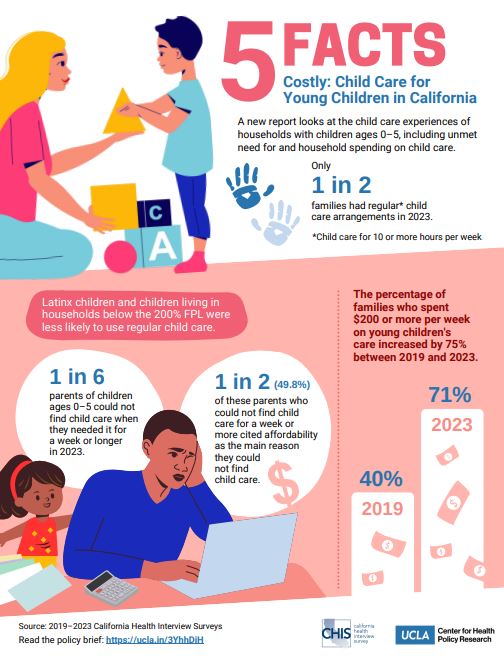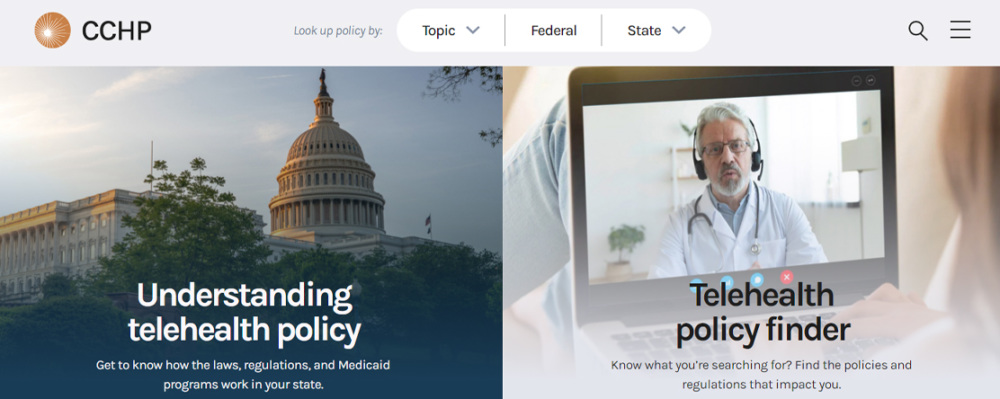
Report: Regular Child Care is Out of Reach for Nearly Half of Young Children in California
- Nicole Lordi, MSC(d)
- Veronica Villacorta, Jackie Thu-Hương Wong, Angelo Williams, Martha E. Dominguez- Brinkley, Rudiel Fabian, Won Lee
-
Focus Areas
Women, Youth & Children -
Issues
Reproductive & Sexual Health -
Expertise
Research – Quantitative, Research – Surveillance -
Programs
Nicole Lordi, Researcher

Less than half of young children ages 0–5 in California have regular child care arrangements, and Latinx and lower-income families in California are more likely to have difficulties accessing child care, finds the 2023 California Health Interview Survey (CHIS).
In this policy brief, co-authored by PHI’s Nicole Lordi, researchers used CHIS data (2019–2023) to describe the child care experiences of households with young children 0–5 years old, including unmet need for child care and household spending on child care. They found that young Latinx children, who make up 46% of children ages 0–5 in the state, and young children from low-income households are less likely than the state average to have regular child care—10 or more hours per week, excluding child care provided by parents, legal guardians, or stepparents.
CHIS is a collaboration of the UCLA Center for Health Policy Research, the California Department of Public Health, the California Department of Health Care Services, and the Public Health Institute.
see the study and related materials
Key takeaways
- Less than half (46%) of young children in California ages 0–5 had regular child care arrangements in 2023.
- 1 in 6 parents of children ages 0–5 could not find child care when they needed it for a week or longer in 2023.
- 7 in 10 households with children ages 0–5 spent $200 or more per week on child care in 2023, compared to 4 in 10 households in 2019.
High-quality child care remains out of reach for too many families in California. A lack of regular child care acts as a drag on socioeconomic mobility and overall well-being for families.Nicole Lordi
Researcher and lead study author, Public Health Institute
Based on the 2023 federal poverty level (FPL) of $30,000 for a family of four, families with lower incomes were less likely to have access to regular child care. The report showed:
- More than half (53.7%) of children living in households earning 300% or more of the FPL ($90,000 for a family of four) had regular child care.
- Less than a quarter (23.7%) of children living in households earning between 100–199% of the FPL had regular child care.
- Slightly more than a quarter (26.7%) of children living in households earning between 0–99% of the FPL had regular child care.
Examining the data by race and ethnicity also showed differences. In 2023, white children ages 0–5 years were more likely to have regular child care than the overall population of young children (56.7% vs. 46%). The figures were 34.3% of young Latinx children, 55.9% of young Black or African American children, and 53.5% of young Asian children.
California ranked 35th in the United States in child well-being, according to “2023 KIDS COUNT” data from the Annie E. Casey Foundation. That report links California’s ranking in child well-being to the inability of many California households to access affordable and high-quality child care. The new report cites research showing that child care allows parents to work and to remain employed, while supporting a child’s development.

Originally published by UCLA
Work With Us
You change the world. We do the rest. Explore fiscal sponsorship at PHI.
Support Us
Together, we can accelerate our response to public health’s most critical issues.
Find Employment
Begin your career at the Public Health Institute.


